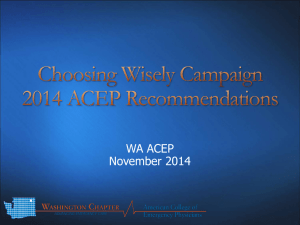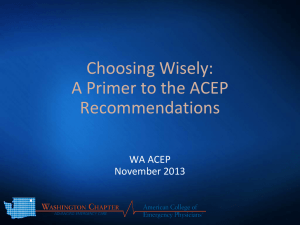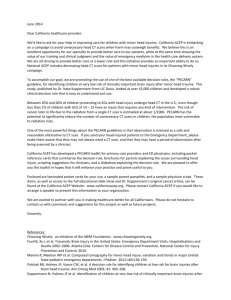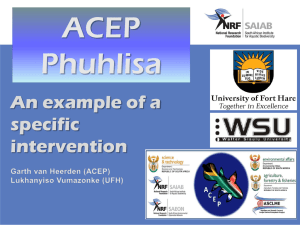2013 Resolutions Adopted by the Council & Board of Directors
advertisement
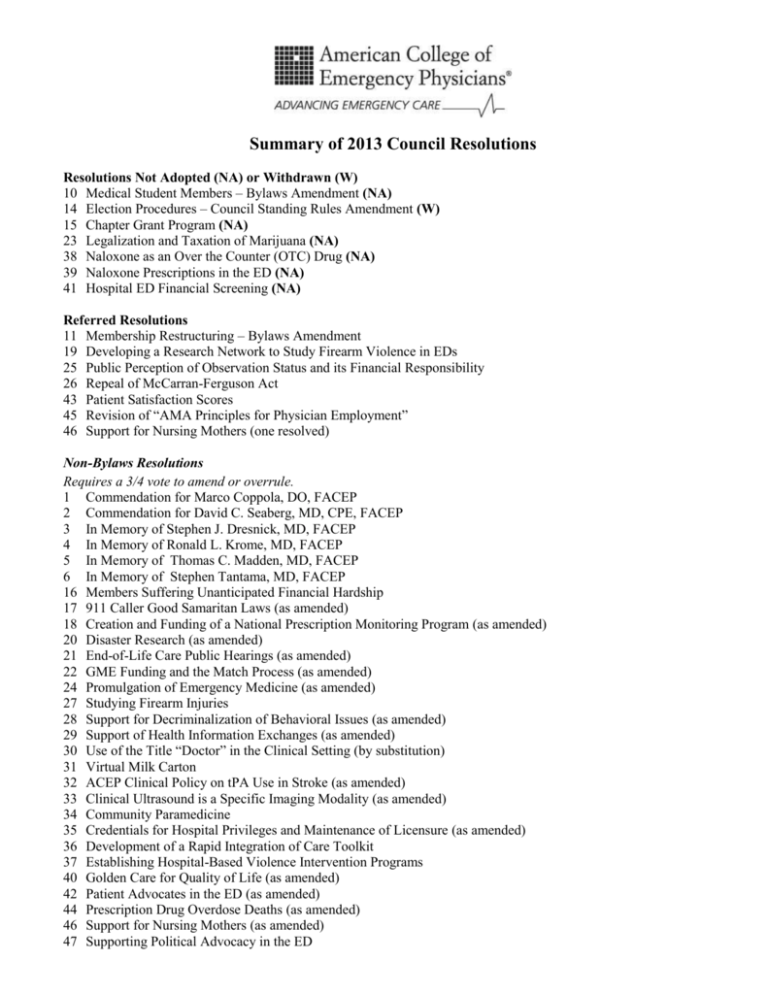
Summary of 2013 Council Resolutions Resolutions Not Adopted (NA) or Withdrawn (W) 10 Medical Student Members – Bylaws Amendment (NA) 14 Election Procedures – Council Standing Rules Amendment (W) 15 Chapter Grant Program (NA) 23 Legalization and Taxation of Marijuana (NA) 38 Naloxone as an Over the Counter (OTC) Drug (NA) 39 Naloxone Prescriptions in the ED (NA) 41 Hospital ED Financial Screening (NA) Referred Resolutions 11 Membership Restructuring – Bylaws Amendment 19 Developing a Research Network to Study Firearm Violence in EDs 25 Public Perception of Observation Status and its Financial Responsibility 26 Repeal of McCarran-Ferguson Act 43 Patient Satisfaction Scores 45 Revision of “AMA Principles for Physician Employment” 46 Support for Nursing Mothers (one resolved) Non-Bylaws Resolutions Requires a 3/4 vote to amend or overrule. 1 Commendation for Marco Coppola, DO, FACEP 2 Commendation for David C. Seaberg, MD, CPE, FACEP 3 In Memory of Stephen J. Dresnick, MD, FACEP 4 In Memory of Ronald L. Krome, MD, FACEP 5 In Memory of Thomas C. Madden, MD, FACEP 6 In Memory of Stephen Tantama, MD, FACEP 16 Members Suffering Unanticipated Financial Hardship 17 911 Caller Good Samaritan Laws (as amended) 18 Creation and Funding of a National Prescription Monitoring Program (as amended) 20 Disaster Research (as amended) 21 End-of-Life Care Public Hearings (as amended) 22 GME Funding and the Match Process (as amended) 24 Promulgation of Emergency Medicine (as amended) 27 Studying Firearm Injuries 28 Support for Decriminalization of Behavioral Issues (as amended) 29 Support of Health Information Exchanges (as amended) 30 Use of the Title “Doctor” in the Clinical Setting (by substitution) 31 Virtual Milk Carton 32 ACEP Clinical Policy on tPA Use in Stroke (as amended) 33 Clinical Ultrasound is a Specific Imaging Modality (as amended) 34 Community Paramedicine 35 Credentials for Hospital Privileges and Maintenance of Licensure (as amended) 36 Development of a Rapid Integration of Care Toolkit 37 Establishing Hospital-Based Violence Intervention Programs 40 Golden Care for Quality of Life (as amended) 42 Patient Advocates in the ED (as amended) 44 Prescription Drug Overdose Deaths (as amended) 46 Support for Nursing Mothers (as amended) 47 Supporting Political Advocacy in the ED Summary of 2013 Council Resolutions Page 2 48 Topical Anesthetics in the ED (as amended) 49 Triage-Based Protocols to Optimize ED Front End Operations (as amended) 50 Commendation for Andrew I. Bern, MD, FACEP Bylaws Resolutions Requires a 2/3 affirmative vote of the Board of Directors for adoption. 7 Candidate Members in Fellowship Training (as amended) 8 Council Officers "Standing" in the ACEP Bylaws 9 Criteria for Inclusion of Orgs in the ACEP Council (as amended) College Manual Resolutions Requires majority vote for adoption. 12 Procedures for Addressing Ethics Charges 13 Criteria for Eligibility & Approval of Organizations Seeking Representation in the Council (as amended) 2013 Resolutions Adopted by the Council & Board of Directors Resolution 1 Commendation for Marco Coppola, DO, FACEP RESOLVED, That the American College of Emergency Physicians commends Marco Coppola, DO, FACEP, for his service as Council Speaker and Council Vice Speaker and for his commitment and dedication to the specialty of emergency medicine and to the patients we serve. Resolution 2 Commendation for David C. Seaberg, MD, CPE, FACEP RESOLVED, That the American College of Emergency Physicians commends David C. Seaberg, MD, CPE, FACEP, for his outstanding service, leadership, and commitment to the specialty of emergency medicine and to the College. Resolution 3 In Memory of Stephen J. Dresnick, MD, FACEP RESOLVED, That the American College of Emergency Physicians remembers with honor the contributions made by Stephen J. Dresnick, MD, FACEP, for serving as President of FCEP, serving a Speaker and Vice Speaker of ACEP, and through his promotion of the specialty of emergency medicine; and be it further RESOLVED, That the American College of Emergency Physicians extends to the family, friends, and colleagues of Dr. Dresnick our deepest sympathy, our sense of sadness and loss, and our gratitude for having worked with and learned from a remarkable individual. Resolution 4 In Memory of Ronald L. Krome, MD, FACEP RESOLVED, That the American College of Emergency Physicians extends its deepest sympathy to the family, friends, and colleagues of Ronald L. Krome MD FACEP; and be it further RESOLVED, That the American College of Emergency Physicians respectfully celebrates the life and legacy of Dr. Krome and will continuously honor his achievements on behalf of emergency physicians, the specialty of Emergency Medicine, and all emergency patients; and be it further RESOLVED, That Dr. Krome will always be remembered as a tireless doer who led by example, by accomplishment, and by nurturing the people around him – Ron was a true mensch. Resolution 5 In Memory of Thomas C. Madden, MD, FACEP RESOLVED, That national ACEP and the Indiana Chapter extends to his wife, Terri, his children, Lauren, Erin and Austin, his friends, family, and his colleagues our condolences and gratitude for his service to the specialty of Emergency Medicine. Resolution 6 In Memory of Stephen Tantama, MD, FACEP RESOLVED, That the American College of Emergency Physicians recognizes Stephen Tantama, MD, FACEP, for his dedication, professionalism, and contributions to emergency medicine, ACEP, the Council, the Government Services Chapter, the Young Physicians Section, EMRA and the RRC-EM; and be it further RESOLVED, That ACEP extends to Dr. Tantama’ s family, friends, and colleagues our sympathy, great sense of sadness and loss, and our gratitude for having been able to share a part of his life. Resolution 7 Candidate Members in Fellowship Training (as amended) RESOLVED, That the ACEP Bylaws, Article IV – Membership, Section 2.5 – Candidate Members, and Article V – Fellowship, Section 1 – Fellow Status, be amended to read: Section 2.5 — Candidate Members Any medical allopathic or osteopathic medical student, intern, or physician participating in an emergency medicine residency or fellowship shall be eligible for candidate membership. Individuals going directly from any residency into subspecialty fellowship training, the that upon completion of which would qualify them for active membership, may opt are eligible to be candidate members for the duration of their fellowship. Effective January 1, 2000, pPhysicians in the uniformed services while serving as general medical officers shall be eligible for candidate membership for a maximum of four years. ARTICLE V – FELLOWSHIP Section 1 – Fellow Status 2013 Resolutions Adopted by the Council & Board of Directors Page 2 Fellows of the College shall meet one of the following two sets of criteria: 1. Be active, life, honorary, or international members for three continuous years immediately prior to election and must have been certified in emergency medicine at the time of election by the American Board of Emergency Medicine, the American Osteopathic Board of Emergency Medicine, or in pediatric emergency medicine by the American Board of Pediatrics. Maintenance of Fellow status requires continued membership in the College. In addition, the following requirements demonstrating evidence of high professional standing must be met by candidates some time during their professional career prior to application. A. At least three years of active involvement in emergency medicine as the physician's chief professional activity, exclusive of residency training, and; B. Satisfaction of at least three of the following individual criteria during their professional career: 1. active involvement, beyond holding membership, in voluntary health organizations, organized medical societies, or voluntary community health planning activities or service as an elected or appointed public official; 2. active involvement in hospital affairs, such as medical staff committees, as attested by the emergency department director or chief of staff; 3. active involvement in the formal teaching of emergency medicine to physicians, nurses, medical students, out-of-hospital care personnel, or the public; 4. active involvement in emergency medicine administration or departmental affairs; 5. active involvement in an emergency medical services system; 6. research in emergency medicine; 7. active involvement in ACEP chapter activities as attested by the chapter president or chapter executive director; 8. member of a national ACEP committee, the ACEP Council, or national Board of Directors; 9. examiner for, director of, or involvement in test development and/or administration for the American Board of Emergency Medicine or the American Osteopathic Board of Emergency Medicine; 10. reviewer for or editor or listed author of a published scientific article or reference material in the field of emergency medicine in a recognized journal or book. 2. Be active, life, honorary, or international members for six continuous years immediately prior to election and eligible for membership at the close of business on December 31, 1999. Candidate must complete and submit application along with all documentation and supporting elements prior to close of business December 31, 2009. After that date, no further new applications for fellow status under the second set of criteria (subsection 2) will be considered. Furthermore, all applications received by close of business December 31, 2009, will have either final approval or disapproval no later than close of business December 31, 2010. Maintenance of Fellow status requires continued membership in the College. In addition, the following requirements demonstrating evidence of high professional standing must be met by candidates sometime during their professional career prior to application: A. At least ten years of active involvement in emergency medicine as the physician's chief professional activity, exclusive of training, and; B. Satisfaction of at least three of the following individual criteria, of which one of the three must be number 7 or number 8, during their professional career: 1. active involvement, beyond holding membership, in voluntary health organizations, organized medical societies, or voluntary community health planning activities or service as an elected or appointed public official; 2. active involvement in hospital affairs, such as medical staff committees, as attested by the emergency department director or chief of staff; 3. active involvement in the formal teaching of emergency medicine to physicians, nurses, medical students, out-of-hospital care personnel, or the public; 4. active involvement in emergency medicine administration or departmental affairs; 5. active involvement in an emergency medical services system; 6. research in emergency medicine; 7. active involvement in ACEP chapter activities as attested by the chapter president or chapter executive director; 8. member of a national ACEP committee, the ACEP Council, or national Board of Directors; 2013 Resolutions Adopted by the Council & Board of Directors Page 3 9. examiner for, director of, or involvement in test development and/or administration for the American Board of Emergency Medicine or the American Osteopathic Board of Emergency Medicine; 10. reviewer for or editor or listed author of a published scientific article or reference material in the field of emergency medicine in a recognized journal or book. In addition, the candidate must provide a written letter of recommendation from their chapter, as attested by the chapter president or chapter executive director, or two letters of recommendation from current Fellows of the College. Provision of documentation of the satisfaction of the above criteria is the responsibility of the candidate, and determination of the satisfaction of these criteria shall be by the Board of Directors of ACEP or its designee. Fellows shall be authorized to use the letters FACEP in conjunction with professional activities. Fees, procedures for election, and reasons for termination of Fellows shall be determined by the Board of Directors. Resolution 8 Council Officers "Standing" in the ACEP Bylaws RESOLVED, That the ACEP Bylaws Article X – Officers/Executive Director, Section 11 – Speaker and Section 12 – Vice Speaker, be amended to read: Section 11 — Speaker The term of office of the speaker of the Council shall be two years. The speaker shall attend meetings of the Board of Directors and may address any matter under discussion. The speaker shall preside at all meetings of the Council, except that the vice speaker may preside at the discretion of the speaker. The speaker shall prepare, or cause to be prepared, the agendas for the Council. The speaker may appoint committees of the Council and shall inform the councillors of the activities of the College. The speaker's term of office shall begin immediately following the conclusion of the annual meeting at which the election occurred and shall conclude at such time as a successor takes office. The speaker shall not have the right to vote in the Council except in the event of a tie vote of the councillors. During the term of office, the speaker is ineligible to accept nomination to the Board of Directors of the College. No speaker may serve consecutive terms. Section 12 — Vice Speaker The term of office of the vice speaker of the Council shall be two years. The vice speaker shall attend meetings of the Board of Directors and may address any matter under discussion. The vice speaker shall assume the duties and responsibilities of the speaker if the speaker so requests or if the speaker is unable to perform such duties. The term of the office of the vice speaker shall begin immediately following the conclusion of the annual meeting at which the election occurred and shall conclude at such time as a successor takes office. During the term of office, the vice speaker is ineligible to accept nomination to the Board of Directors of the College. No vice speaker may serve consecutive terms. Resolution 9 Criteria for Inclusion of Orgs in the ACEP Council (as amended) RESOLVED, The ACEP Bylaws Article VIII – Council, Section 1 – Composition of the Council, be amended to read: Each chartered chapter shall have a minimum of one councillor as representative of all of the members of such chartered chapter. There shall be allowed one additional councillor for each 100 members of the College in that chapter as shown by the membership rolls of the College on December 31 of the preceding year. However, a member holding memberships simultaneously in multiple chapters may be counted for purposes of councillor allotment in only one chapter. An organization currently serving as, or seeking representation as, a component body of the Council must meet, and continue to meet, the criteria stated in the College Manual. These criteria do not apply to chapters or sections of the College. EMRA shall be entitled to four councillors as representative of all of the members of EMRA, each of whom shall be a candidate or active member of the College. 2013 Resolutions Adopted by the Council & Board of Directors Page 4 AACEM shall be entitled to one councillor as representative of all of the members of AACEM, who shall be an active member of the College. CORD shall be entitled to one councillor, who shall be an active member of the College, as representative of all of the members of CORD. SAEM shall be entitled to one councillor, who shall be an active member of the College, as representative of all of the members of SAEM. Each chartered section shall be entitled to one councillor as representative of all of the members of such chartered section if the number of section dues-paying and complimentary candidate members meets the minimum number established by the Board of Directors for the charter of that section based on the membership rolls of the College on December 31 of the preceding year. A councillor representing one component body may not simultaneously represent another component body as a councillor or alternate councillor. Each component body shall also elect or appoint alternate councillors who will be empowered to assume the rights and obligations of the sponsoring body's councillor at Council meetings at which such councillor is not available to participate. An alternate councillor representing one component body may not simultaneously represent another component body as a councillor or alternate councillor. Councillors shall be certified by their sponsoring body to the Council secretary on a date no less than 60 days before the annual meeting. Resolution 12 Procedures for Addressing Charges of Ethical Violations and Other Misconduct – College Manual Amendment RESOLVED, That the College Manual be amended by substitution of the “Procedures for Addressing Charges of Ethical Violations and Other Misconduct.” Resolution 13 Criteria for Eligibility & Approval of Organizations Seeking Representation in the Council – College Manual Amendment RESOLVED, The College Manual be amended by addition of a new section “Criteria for Eligibility & Approval of Organizations Seeking Representation in the ACEP Council” to read: Organizations that seek representation as a component body in the Council of the American College of Emergency Physicians (ACEP) must meet, and continue to meet, the following criteria: A. Non-profit. B. Makes an important contribution to emergency medicine that is not already adequately represented in the Council. C. Not in conflict with the Bylaws and policies of ACEP. D. Physicians comprise the majority of the voting membership of the organization. E. A majority of the organization’s physician members are ACEP members. F. Established, stable, and in existence for at least 5 years prior to requesting representation in the ACEP Council. G. National in scope, membership not restricted geographically, and members from a majority of the states. If international, the organization must have a U.S. branch or chapter in compliance with these guidelines. H. Seek representation as a component body through the submission of a Bylaws amendment. The College will audit these component bodies every two years to ensure continued compliance with these guidelines. Resolution 16 Members Suffering Unanticipated Financial Hardship RESOLVED, That ACEP acknowledges the need to support its members during times of economic hardship; be it further RESOLVED, That ACEP develop policies to address requests for financial consideration for a dues waiver in times of economic hardship, and the procedures by which such cases will be evaluated. Resolution 17 911 Caller Good Samaritan Laws (as amended) RESOLVED, That ACEP supports and endorses 911 Caller Good Samaritan policies for overdose victims; and be it further RESOLVED, That ACEP support 911 Caller Good Samaritan policies through legislative or regulatory advocacy at the local, state, and national levels; and be it further RESOLVED, That ACEP work with the AMA on 911 Caller Good Samaritan policies. 2013 Resolutions Adopted by the Council & Board of Directors Page 5 Resolution 18 Creation and Funding of a National Prescription Monitoring Program (as amended) RESOLVED, That ACEP work with all involved parties to support a best practice-based, voluntary, federally funded, nationally accessible Prescription Monitoring Program; and be it further RESOLVED, That ACEP oppose mandatory query of prescription drug monitoring program data for emergency department patients. Resolution 20 Disaster Research (as amended) RESOLVED, That ACEP work with other organizations to develop guidelines for evaluation of new or ongoing projects in the areas of disaster preparedness, response, effectiveness of interventions, and outcomes research to identify the most robust areas to focus funding; and be it further RESOLVED, That ACEP work with other organizations to increase disaster research funding until guidelines on appropriate funding for research on disaster preparedness, response, and effectiveness of interventions can be established. Resolution 21 End-of-Life Care Public Hearings (as amended) RESOLVED, That ACEP work with other relevant stakeholders to engage in a national conversation and make recommendations on end-of-life issues. Resolution 22 GME Funding and the Match Process (as amended) RESOLVED, That ACEP continue to support the National Residency Match Program and National Matching Services processes as it currently exists; and be it further RESOLVED, That ACEP oppose the hiring of emergency medicine residents through processes outside of the National Residency Match Program and National Matching Services; and be it further RESOLVED, That ACEP support efforts of sponsoring institutions to secure adequate federal funding of Graduate Medical Education (GME) for emergency medicine and support independent financing without replacing currently funded GME positions in emergency medicine or violating the Match process to train emergency medicine residents. Resolution 24 Promulgation of Emergency Medicine (as amended) RESOLVED, That the American College of Emergency Physicians continue efforts, at the direction of the ACEP Board of Directors, to promulgate the value and role of Emergency Medicine as a critical component of an effective health care delivery system to other medical and healthcare organizations, the media, and the American public, and to provide emergency physicians and other interested parties with board-approved materials for use in discussions on the topic. Resolution 27 Studying Firearm Injuries RESOLVED, That ACEP advocate for appropriate, adequate funding for rigorous research on firearm injury prevention; and be it further RESOLVED, That ACEP join with the American Medical Association and other medical societies with similar resolutions to work together toward achieving this common cause. Resolution 28 Support for Decriminalization of Behavioral Issues (as amended) RESOLVED, That ACEP study the emerging alternatives to incarceration for individuals with substance dependence disorders and mental health problems in the United States; and be it further RESOLVED, That ACEP devise ways to support the appropriate delivery of mental health, psychiatric care, and substance dependence disorder treatment options as alternatives to incarceration. Resolution 29 Support of Health Information Exchanges (as amended) RESOLVED, That ACEP investigate and support Health Information Exchanges; and be it further RESOLVED, That ACEP work with appropriate stakeholders to promote the development, implementation, and utilization of a national Health Information Exchange; and be it further RESOLVED, That ACEP develop an Information Paper exploring a national Health Information Exchange. 2013 Resolutions Adopted by the Council & Board of Directors Page 6 Resolution 30 Use of the Title “Doctor” in the Clinical Setting (by substitution) RESOLVED, That ACEP affirm that a physician is an individual who has received a "Doctor of Medicine" or a "Doctor of Osteopathic Medicine" degree or an equivalent degree following successful completion of a prescribed course of study from a school of medicine or osteopathic medicine; and be it further RESOLVED, That ACEP require anyone in a hospital environment who has direct contact with a patient who presents himself or herself to the patient as a “doctor,” and who is not a “physician” according to the definition above, must specifically and simultaneously declare themselves a "non-physician" and define the nature of their doctorate degree. Resolution 31 Virtual Milk Carton RESOLVED, That ACEP communicate to its members that they consider using the National Center for Missing and Exploited Children’s Missing Children Screensaver and post AMBER Alerts in their emergency departments. Resolution 32 ACEP Clinical Policy on tPA Use in Stroke (as amended) RESOLVED, That ACEP reconsider the current “Clinical Policy: Use of Intravenous tPA for the Management of Acute Ischemic Stroke in the Emergency Department” including opening the discussion regarding the use of tPA to the ACEP membership; and be it further RESOLVED, That any subsequent ACEP clinical policy be open to comment by the ACEP membership for a period of at least 60 days before consideration of adoption. Resolution 33 Clinical Ultrasound is a Specific Imaging Modality (as amended) RESOLVED, That ACEP define Clinical Ultrasonography as a diagnostic modality; and be it further RESOLVED, That ACEP recognizes that Clinical Ultrasonography goes beyond clinically important data not obtainable by inspection, palpation, auscultation, or other components of the physical exam; and be it further RESOLVED, That ACEP recognize Clinical Ultrasonography as a unique clinical modality, distinct from the physical examination, and not an adjunct to or extension of the physical examination. Resolution 34 Community Paramedicine RESOLVED, That ACEP develop a policy statement defining community paramedicine; and be it further RESOLVED, That ACEP develop a policy statement outlining the role of the pre-hospital provider in community paramedicine; and be it further RESOLVED, That ACEP develop guidelines and standards for community paramedicine; and be it further RESOLVED, That ACEP develop a clinical model for community paramedicine. Resolution 35 Credentials for Hospital Privileges and Maintenance of Licensure (as amended) RESOLVED, That the American College of Emergency Physicians adopt a position that board certification in emergency medicine through the American Board of Emergency Medicine and/or the American Osteopathic Board of Emergency Medicine and/or sub board on Pediatric Emergency Medicine of the American Board of Pediatrics, along with participation in Maintenance of Certification programs currently required by these Boards is sufficient for practicing emergency physicians to maintain hospital privileges, health plan participation and medical group inclusion, and Maintenance of Licensure; and be it further RESOLVED, That requiring additional certifications beyond board certification for emergency physicians, such as Basic Life Support, Advanced Cardiac Life Support, Advanced Trauma Life Support, and Pediatric Advanced Life Support, and other maintenance programs is redundant and unnecessary. Resolution 36 Development of a Rapid Integration of Care Toolkit RESOLVED, That ACEP develop a rapid integration of care toolkit that would focus on both transitions of care and care coordination, provide best practices based upon hospital type and location, tools/resources for the design and implementation of rapid integration of care programs, and measures to report success of efforts. 2013 Resolutions Adopted by the Council & Board of Directors Page 7 Resolution 37 Establishing Hospital-Based Violence Intervention Programs RESOLVED, That ACEP promote awareness of hospital-based violence intervention programs as evidencebased solutions for violence reduction; and be it further RESOLVED, That ACEP coordinate with relevant stakeholders to provide resources for those who wish to establish hospital-based violence intervention programs. Resolution 40 Golden Care for Quality of Life (as amended) RESOLVED, That the American College of Emergency Physicians encourage palliative and hospice care consults in the emergency department to increase provider and patient awareness of their utility based on the patient’s stage of planning; and be it further RESOLVED, That emergency physicians respect the dying patient’s needs for care, comfort, and compassion and employ communication skills that acknowledge the cultural, religious and individual factors that play into family and patient decision making at the end of life; and be it further RESOLVED, That ACEP support funding for research related to goal directed care in critically ill patients, palliative and hospice care in the emergency setting, and better access to advance directives and DNAR orders in the emergency department; and be it further RESOLVED, That ACEP’s advocacy initiatives bring more attention to the importance of access to and enforcement of advance directives and/or DNAR orders and the significant amount of health care dollars that are spent on unwanted admissions and invasive procedures at the end of life. Resolution 42 Patient Advocates in the ED (as amended) RESOLVED, That ACEP develop a policy statement regarding the role and the training of the patient advocate in the emergency department. Resolution 44 Prescription Drug Overdose Deaths (as amended) RESOLVED, That ACEP utilize existing organizational structure to review solutions that have worked to decrease the death rate from prescription drug overdoses; and be it further RESOLVED, That the College create a document offering best practice solutions that can be adopted at any level to impact the epidemic of prescription drug overdoses with the ultimate goal of showing a reduction in the number of deaths from this method. Resolution 46 Support for Nursing Mothers (as amended) RESOLVED, That ACEP promote and endorse the availability of a private, non-bathroom area for breastfeeding emergency department employees, nurses, and physicians to express breast milk during their workday inside or directly proximal to the emergency department; and be it further RESOLVED, That ACEP provide a private, non-bathroom area at the ACEP Council as well as at other sponsored meetings at the request of a breastfeeding mother; and be it further RESOLVED, That ACEP support the education of emergency department provider employers and hospitals on the benefits of breastfeeding support in the workplace for infants, mothers, and the business of emergency medicine. Resolution 47 Supporting Political Advocacy in the ED RESOLVED, That the American College of Emergency Physicians adopt as policy the following statement from the 2012 American Medical Association’s Principles for Physician Employment: Employed physicians should be free to exercise their personal and professional judgment in voting, speaking, and advocating on any matter regarding patient care interests, the profession, health care in the community, and the independent exercise of medical judgment. Employed physicians should not be deemed in breach of their employment agreements, nor be retaliated against by their employers, for asserting these interests. Resolution 48 Topical Anesthetics in the ED (as amended) RESOLVED, That ACEP provide educational materials to members about the importance of pain reduction with available topical anesthetics such as LMX cream for lumbar punctures in children, and L.E.T. (lidocaine, epinephrine, tetracaine) gel for suturing. 2013 Resolutions Adopted by the Council & Board of Directors Page 8 Resolution 49 Triage-Based Protocols to Optimize ED Front End Operations (as amended) RESOLVED, That ACEP, in collaboration with ENA, develop a position statement that will allow the adoption of triage based protocols, which may be initiated prior to a physician’s order, as an effective strategy to improve the delivery of emergency care and that this joint position statement be available for dissemination to regulatory agencies at a statewide and national level. Resolution 50 Commendation for Andrew I. Bern, MD, FACEP RESOLVED, That the American College of Emergency Physicians thanks and commends Andrew I. Bern, MD, FACEP, for his many years of leadership, dedication, service, and his steadfast commitment to his colleagues and fellow members of the College.


